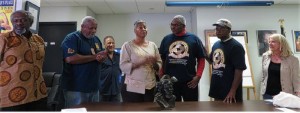Meeting celebrates Million Worker March Movement

From left to right: Chris Silvera, Larry Holmes, Brenda Stokely, Clarence Thomas, Charles Jenkins and Sharon Black. All were either coordinators or organizers
for the 2004 MWMM rally.
WW photo: Monica Moorehead
Founding members of the Million Worker March Movement held a 10th commemorative anniversary meeting Oct. 16 at Teamsters Local 808 in Long Island City, Queens, N.Y. The guest of honor was Clarence Thomas, national co-chair of the MWMM and a long-time, rank-and-file leader of the International Longshore and Warehouse Union, Local 10, from California’s Bay Area. Charles Jenkins, president of the New York City chapter of the Coalition of Black Trade Unionists, emceed the program.
MWMM leaders expressed their solidarity at the event with Jerome Thompson, who shared his experience of being fired by Cablevision in Brooklyn for attempting to organize a union.
The meeting reviewed some of the important contributions that the MWMM has made to the struggles of working and oppressed people here and worldwide. These include helping to revive May Day at Union Square in New York City in 2005 and supporting the one-day country-wide general strike led by millions of immigrant workers on May Day 2006.
The MWMM debuted on Oct. 17, 2004, when some 10,000 workers gathered at the Lincoln Memorial, where the Rev. Dr. Martin Luther King Jr. had declared war on poverty 36 years earlier. Trent Willis — a young African-American Bay Area longshore worker — had come up with the idea of organizing the Million Worker March Movement, which relit the spark of conscious working-class struggle with a program that is even more relevant today.
The MWMM call declared: “The time has come to mobilize working people for our own agenda. Let us end subservience to the power of the privileged few and their monopoly of the political process in America.”
Their multi-issue program demanded universal single-payer health care; protection and enhancement of Social Security with guaranteed pensions; cancelling corporate “free trade” agreements; and an end to privatization, contracting out of labor and deregulation of industry. It demanded workers’ right to organize and the repeal of the Taft-Hartley Act, the Patriot Act, the Anti-Terrorism Act and all such repressive laws.
The MWMM called for slashing the military budget, recovering public funds from war profiteers, and increasing taxes on the corporations and the rich, while prioritizing the building of schools, financing public schools’ arts programs, and funding an army of teachers to end illiteracy. Rebuild the cities, it said, with affordable housing to end homelessness.
It also called for an end to the criminalization of poverty and the prison-industrial complex, enforcing civil rights and granting amnesty to all undocumented workers. The call stressed that mobilizations must be held to protest racism and discrimination. Democratize the economy and the media and open the books of the Pentagon and intelligence agencies, it said. The MWMM also demanded an emergency program to restore the environment and end global warming.
Although many in the labor officialdom at that time considered such a march to be a good idea, it was 2004, a presidential election year. They chose instead to subordinate the needs of working women and men to the upcoming capitalist elections, channeling resources and energy away from independent action.
However, thousands of workers overcame these obstacles. From coast to coast, they traveled to Washington to mobilize in their own name, the name of the independent working class. This voice grows stronger today in the fight for a $15 per hour minimum wage and a union, and in the struggles against police killings and mass incarceration.

